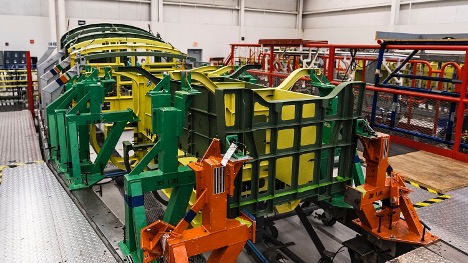By Australian Defence Business Review
Production of the first Northrop Grumman MQ-4C Triton unmanned maritime ISR aircraft for the RAAF commenced in late October at the company’s Moss Point facility in Mississippi.
Being acquired under a cooperative development program with the US Navy, the RAAF currently has a requirement for six MQ-4Cs, and the commonwealth has to date committed funding to three air vehicles, ground control segments, and the construction of facilities at two main operating bases and one forward operating base.
“The MQ-4C Triton will be a very important ISR capability for Australia,” RAAF’s air attaché to the Australian embassy, AIRCDRE Terry van Haren said in a statement. “It is ideally suited for Australian operating conditions, given its high altitude, long endurance, and impressive sensor suite. The Royal Australian Air Force looks forward to operating the MQ-4C alongside its other ISR and response aircraft such as the P8A Poseidon.”
US Navy Triton program director, Capt Dan Mackin added, “With much of our team working remotely, geographically dispersed, and across many time zones, I am so impressed with the continued productivity I have seen and the great work being done. Our partnership near and far remains strong as we prepare to deliver the first Triton aircraft to Australia in 2023.”
Australia is expected to soon decide on whether to accelerate its program by taking two production slots previously allocated to the US Navy but which have seen funding withheld in the draft FY2021 President’s Budget for FY 2021 and 2022.
“A two-year gap in production would have significant negative effects on the production line and the supplier base,” Northrop Grumman’s vice president Triton programs, Doug Shaffer said in a release. “A pause would mean we risk losing the lessons learned that have enabled our suppliers and Northrop Grumman to achieve production efficiencies and get to this mature point of the program, which would then add more risks and costs to the program.
“We estimate that stopping and restarting the line alone will cost roughly $150 million and then each aircraft likely costs about $20 million more,” Shaffer added. “Consequently, we are talking to Congress and our Navy customer about opportunities to sustain the production line, protect our suppliers and support the program long-term.
“We have had multiple discussions with the US Navy and Australia about options to help fill the FY ’21 and ’22 production lines with Australian aircraft. An acceleration of the Australian program would result in significant savings to Australia and ensure cost savings to the US Navy by helping prevent a pause in Triton production.”
In the meantime, the US Navy says the Triton has proven to be an “invaluable asset” since being deployed to Guam earlier this year as part of the system’s early operational capability (EOC).
“Triton is quickly providing vital information to operational users,” Shaffer said. “This game-changing, persistent system is going to revolutionize the Navy’s maritime ISR capabilities by providing an unprecedented amount of data to inform critical decision making.”
This article was published by ADBR on November 6, 2020.
The article was written by Andrew McLaughlin.
The featured photo: The keel of the RAAF’s first MQ-4C Triton in its production jig at Northrop Grumman’s Moss Point, Mississippi facility. (NORTHROP GRUMMAN)


